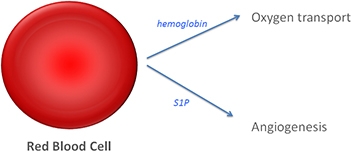Red blood cells are the most abundant cell type in the human body, yet little is known about them apart from their vital role in transporting oxygen to organs and tissues. Now a research team, led by a scientist at Weill Cornell Medical College, has discovered that red blood cells perform a second vital function: angiogenesis, the creation of new blood vessels from those that already exist.
In the Sept. 24 issue of the Journal of Clinical Investigation, investigators show that red blood cells supply a lipid that is known to regulate angiogenesis, sphingosine-1-phosphate (S1P). Angiogenesis is necessary for growth, repair and regenerative processes that require increased blood flow and oxygenation of tissues.
Given its role in creating new blood vessels, scientists recognize S1P as vital to human health — and a player in some diseases, such as cancer. And although S1P is known to be blood borne, no one realized until this study that S1P is supplied by red blood cells to control blood vessel growth, says Dr. Timothy Hla, director of the Center for Vascular Biology at Weill Cornell and a professor of pathology and laboratory medicine.
"It is remarkable that the association between red blood cells and blood vessel formation was missed for so long, but now that we uncovered the link, we are delving into what role this lipid plays in diseases in which red blood cells are defective," says Dr. Hla, who first identified S1P as a key regulator of angiogenesis in his previous research.
The study demonstrated that production of S1P by red blood cells is essential in the formation and development of an embryo. Embryonic development of mutant mice with red blood cells that lacked S1P stopped mid-gestation, but mutant embryos in which S1P was restored developed normally. "An embryo cannot develop if angiogenesis is impaired," Dr. Hla says.

Functions of red blood cells during embryonic development. Image credit: Timothy Hla
Knowing now that red blood cells are responsible for supplying S1P, the next question is whether S1P plays a role in abnormal blood vessels in various tissues when red blood cells are diseased, such as in sickle cell disease, thalassemia, infectious diseases, and cerebral malaria, Dr. Hla says.
"In these conditions, blood vessels become diseased and make organs fail. And if S1P is indeed involved in these disorders— which we don't know yet— drugs that block this lipid could be helpful," he adds. Diseased blood cells that burst or leak, for example, can spill too much S1P into tissue, resulting in unhealthy blood vessels and angiogenesis, Dr. Hla says.
One such inhibitor is already on the market, he says. Because S1P is also known to modulate immune system function, an S1P inhibitor has been approved to treat the inflammatory disease multiple sclerosis. Other S1P inhibitors are also being tested to block immune function or excessive angiogenesis, such as occurs in cancer and other disorders such as psoriasis and rheumatoid arthritis.
"This study further refines our understanding of the vital function of red blood cells, and the role these cells play in health and disease," Dr. Hla says.
Investigators from the University of Texas MD Anderson Cancer Center and the National Institutes of Health's National Institute of Diabetes and Digestive and Kidney Diseases participated in the research.

